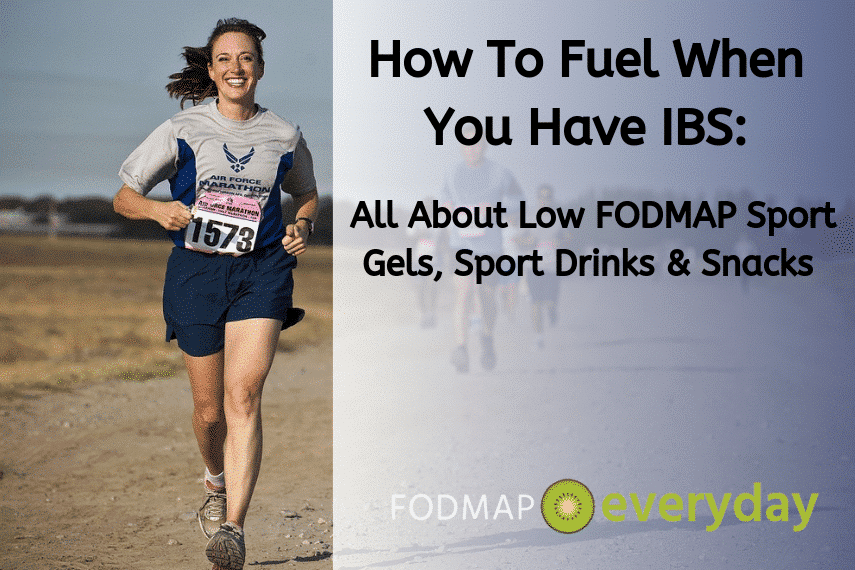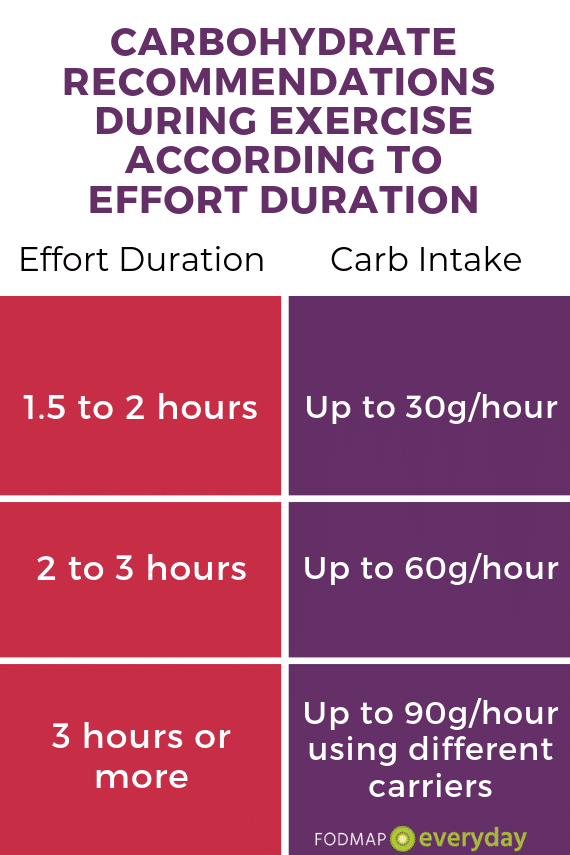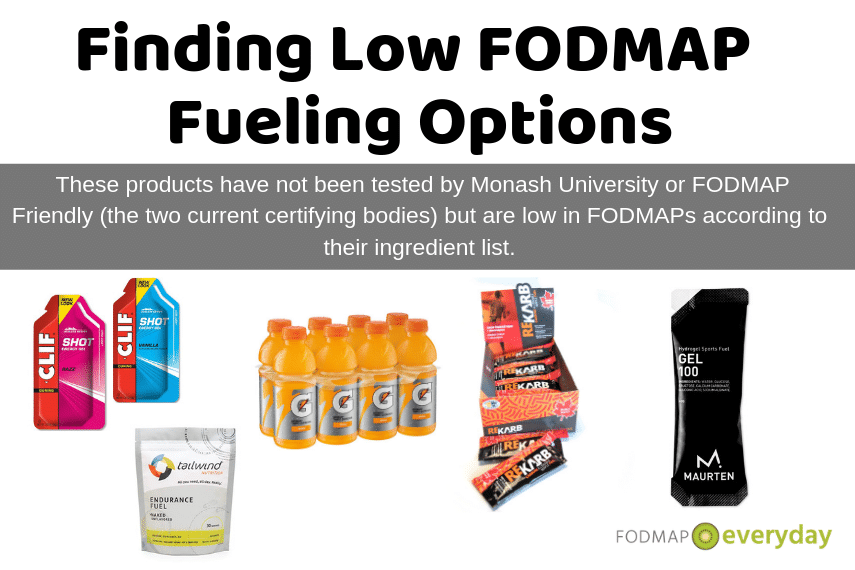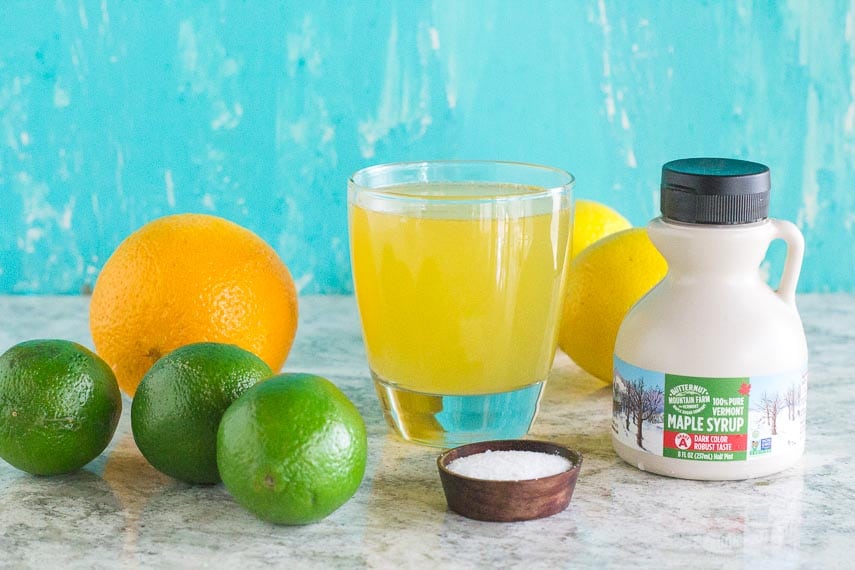How To Fuel When You Have IBS: All About Low FODMAP Sport Gels, Sport Drinks & Snacks
If you have IBS or a sensitive gut and practice sports of extended duration such as endurance running, swimming or cycling, triathlon, hiking or team sports like soccer and hockey, you might find it hard to find sport drinks, gels, bars or snacks that you can tolerate during exercise.
To help you, I came up with suggestions of fueling options that are suitable on a low FODMAP diet, in short, How To Fuel When You Have IBS.
But first, it’s important that you understand what kind of fuel you need!
Fats vs. Carbs: What’s the Best Fuel for Sports Performance?
The Low Carb High Fat (LCHF) diet is very trendy lately. This diet may be tempting for someone who struggles with IBS, since it eliminates a lot of carbs (which means it also eliminates a lot of the high FODMAP foods), all of which can help alleviate GI symptoms.
A high fat, low carbohydrate diet creates metabolic adaptations in just a few days and increases the muscle’s ability to use fat during exercise.
On the other hand, this diet also decreases the use of muscle glycogen during exercise, which is the main source of energy for the muscles.
As a result, the ability to maintain a high intensity effort becomes limited. Fat is a less efficient fuel than carbohydrate because it requires more oxygen to perform the same effort.
Therefore, a low carbohydrate diet is not recommended for athletes and people who engage in high intensity activities as it will impair performance.
[bctt tweet=”Fat is a less efficient fuel than carbohydrate because it requires more oxygen to perform the same effort. ” username=”FODMAPeveryday”]
Know Your Sport
A high fat, low carbohydrate diet will interfere with one’s ability to undertake high quality training and reduce the muscle’s ability to utilise its carbohydrate stores to support high intensity events. Some people might think that high intensity exercise refers only to sprinting, but even an Ironman requires high intensity efforts when performed at a competitive pace.
A low carb high fat diet, however, may potentially be useful in certain situations, such as in ultramarathons and ultra-cycling events lasting more than one day and that require a low to moderate intensity.
It is well established that carbohydrate consumption during an endurance event lasting greater than one hour is associated with improved performance. High-quality meta-analyses and intervention studies show a positive relationship between carbohydrate consumption and endurance performance.
This means that a greater carbohydrate intake during exercise results in better performance than a lower intake.
What If You Are Trying To Lose Weight?
Some studies suggest that a low carb high fat diet could be beneficial for weight loss, at least in the short term. It could promote satiety and reduce hunger. The longer-term effects have not yet been studied further.
Studies are underway to investigate the individual factors that may promote weight loss. Some people may be more successful at losing weight with a lower carbohydrate diet while others may be equally successful at losing weight by reducing their fat intake.
If you are exercising a lot and trying to lose weight, you may benefit from increasing your protein intake to help maintain your muscle mass and increase satiety.
A daily protein intake ranging between 1.5 and 2.3 grams per kg of body weight, divided into 5 or 6 meals/snacks per day is recommended. For a person who weighs 70 kg (154 lbs), this represents 105g to 161g of protein per day.
Carbohydrate Periodization and Train Low
Although carbohydrates consist of an important fuel for exercise, it is not recommended that you consume carbs before or during every workout. Exercising with low carbohydrate availability will allow the creation of positive adaptations, such as increasing the muscle’s ability to use fat during exercise, which is important.
“Training low” refers to training with low carbohydrate availability.
Perhaps the most popular way is training without eating breakfast. However, there are many different ways to train low such as not consuming any carbs during a long workout, or training before bed and not eating any carbs until after working out the next morning (sleep low).
It is important that you plan when to consume carbs and when not to, depending on the type of workout that you are doing, which is called carbohydrate periodization.
For example, it can be appropriate to train without eating breakfast if you are doing a low intensity run of less than one hour. On the other hand, if you are doing a high intensity interval training, you should definitely consume carbs.
How Many Carbs Do You Need During Exercise?
Sports drinks, gels and gummies contain different types of rapidly absorbed sugars: glucose, maltodextrin and fructose.
Some contain only glucose, such as Gatorade, but most product contain a mixture of glucose and fructose or maltodextrin and fructose and may be harder to tolerate for people with IBS, depending on the amount of fructose that they contain.
Sugars need the help of a transporter to move from the intestine into the body’s circulation in order to be absorbed.
Glucose and maltodextrin use a transporter called sodium-dependent transporter, or SGLT1, for absorption.
The transport capacity of this transporter is limited as the transporter becomes saturated at a carbohydrate intake around 60g/h.
Fructose is absorbed using a different carrier called GLUT5, via the liver. In theory, the intestine is able to absorb up to 60g of glucose or maltodextrin per hour and 30g of fructose per hour, for a total of 90g of carbohydrates using both carriers.
There is no advantage in consuming more than 90g of carbohydrate per hour. A carbohydrate intake exceeding this amount will simply not be absorbed and will accumulate in the intestine, causing GI distress.
However, in practice, it can still be hard for endurance athletes to tolerate small carbohydrate during exercise. It is possible to train your ability to use carbohydrates during effort and thus improve your tolerance.
When you get used to consuming carbohydrates during exercise, the number of carbohydrate carriers in your body increases, making it possible for you to absorb more carbohydrate at a time.
On the contrary, if you are not used to it, your ability to absorb carbohydrates is lower, which can cause gastrointestinal problems such as bloating, nausea and diarrhea.
Thus, it is crucial to practice your nutritional strategy ahead of time and during your workouts, at least once a week, for long outings or intense trainings.
It can be noted the form of carbohydrate doesn’t matter. That is to say that consuming carbohydrates in the form of liquid, gels, or gummies has a similar effect on performance.
Start Your Intake Well In Advance
The body can take several weeks to adapt, hence the importance of starting well before the date of a race. It is also important to experiment with different types of drinks and gels to find the ones that work for you, as their effects can vary from a person to another.
The amount of carbohydrates to be consumed during exercise depends on the duration and intensity of the effort as well as the tolerance of the athlete. The table below presents carbohydrate recommendations during exercise according to the effort duration.
It should be noted that these amounts are independent of body weight and should be adjusted downwards for people who exercise at a slower speed.
Knowing that a gel usually contains 25 to 30g of carbohydrates, it is recommended to consume one or two per hour, and up to three per hour for ultra-endurance athletes. The first gel can be consumed 20 to 45 minutes after the start of the race.
Finding Low FODMAP Fueling Options
There are lab tested and certified low FODMAP options, and then products that I recommend based on their ingredient list.
These are lab tested and certified as low FODMAP by Monash University:
- Cerasport Citrus
- Cerasport Ex 1, Pomegranate
Below are products I recommend even though they have not been formally tested for FODMAPs.
-
Clifbar Shot Energy Gel (razz or vanilla) (For Canada Amazon click here)
-
Brix Gel (maple and himalayan salt version, available in Canada only, link is for Amazon Canada)
-
Rekarb Gel (plain maple version only- available in Canada through website linked)
-
Gatorade Thirst Quencher (original, Flow, Fierce and Frost in liquid and powder forms but not Zero or low Sugar versions) For Canada Amazon click here. For UK Amazon click here.
-
Maurten Gel (available through their website only)
-
Tailwind Endurance Fuel (for Canada Amazon click here) (for UK Amazon click here )
-
Skratch Labs Sport Hydration Drink Mix, Lemon Lime (for Canada Amazon click here)
-
Untapped Maple Syrup Athletic Fuel
-
Our Homemade Maple Lime Low FODMAP Sport Drink Recipe
About the Maurten Gel
The Maurten Gel contains 11g of fructose and 14g of glucose. Since it does not contain fructose in excess of glucose, it is potentially low FODMAP, although it has not been tested. Maurten sport products became popular recently when marathon world record holder Eliud Kipchoge started using them and advertising them.
World-class endurance athletes report that Maurten products give them fewer stomach upsets than other sports products they have used before.
Past research has shown that many people cannot take in more than 60 g of carbohydrate per hour without experiencing unpleasant gastrointestinal symptoms.
To help the stomach cope better with high concentrations of sugar during exercise and avoid GI distress, Maurten developed products using a hydrogel technology, which combines alignate (extracted from brown algae) and pectin.
Pectin is found in fruits and vegetables such as apples and tomatoes. Even if pectin is apple derived, it is low FODMAP. According to Maurten, the drink converts to hydrogel when it becomes in contact with the acidity of the stomach, encapsulating the carbohydrates.
The hydrogel then enables a smooth transportation of the carbohydrates, water and sodium through the stomach to the intestine where they are absorbed.
A study compared the Maurten Drink Mix 320 to another sports drink commonly used by endurance athletes called Beta Fuel and to a placebo. The conclusion was that using sodium alginate in a sports drink offers no performance benefit and may actually interfere with digestion and absorption of nutrients.
It should be noted, however, that the study was carried out by the Science in Sports on its own product (Beta Fuel), and does not constitute peer-reviewed, published data.
As mentioned in the table above, most athletes do not need more than 60g of carbohydrate per hour. The hydrogel technology seems to be promising for high-level endurance athletes who cannot stop often during a race but who could benefit from taking a high amount of carbs at one time.
More studies are needed to determine if the hydrogel technology can speed up gastric emptying and help reduce GI symptoms in endurance athletes who have trouble tolerating carbohydrates during exercise.
Low FODMAP Snacks
Here are some ideas of low FODMAP snacks that you can eat when practicing your favorite sports long such as long bike rides and hiking:
-
15 banana chips
-
2 (28g) rice cakes with 2 tablespoons natural peanut butter
-
1 cup of grapes with 1 (28g) string cheese
-
20 (34g) rice crackers with 1 (28 g) string cheese
-
1 medium banana (unripe)
-
1 medium orange with 10 almonds
-
1 (40g) Fody low FODMAP granola bar
-
1 FODMAP Everyday homemade granola bar
-
1 Bobos Bar (safe flavors: chocolate chip oat, maple pecan oat, original, peanut butter oat and peanut butter chocolate chip oat) (For Amazon Canada click here)
How To Choose A Low FODMAP Sports Product
Avoid the following high FODMAP ingredients, which are often found in sports products:
-
Agave
-
Honey
-
Natural flavors
-
Xylitol
-
Sorbitol
-
Mannitol
-
Maltitol
-
Isomalt
-
Concentrates from high FODMAP fruits or vegetables(apple, pear, cherry, mango, peach, beets, watermelon, etc.)
-
Fructo-oligosaccharides or galacto-oligosaccharide
-
Inulin
-
Coconut water (although it is low FODMAP for 3 ounces (100 ml) or less)
-
Fructose
Fructose, especially in the form of high fructose corn syrup (HFCS), should be avoided on the low FODMAP diet. Some ingredients that have an equal glucose to fructose ratio, like table sugar and some fruits, are usually well tolerated by people who have IBS if consumed in moderation.
Products with added fructose and fruits that are high in fructose can cause an excessive intake of fructose and lead to digestive symptoms.
Some ingredients are not high FODMAP, but may trigger symptoms in some people with IBS. These ingredients include:
-
Carrageenan
-
Guar gum
-
Acacia gum
-
Xanthan gum
-
Caffeine
Caffeine can increase GI symptoms in some individuals. You should avoid sports products that contain caffeine unless you have tested them during your workouts and were able to tolerate them without any difficulty.
-
Sucralose and Aspartame
There are no stated serving sizes on the Monash University app for sucralose and aspartame. They are considered safe for most people on the low FODMAP diet but can trigger digestive symptoms in some individuals.
If you can tolerate them, you should still avoid consuming big amounts since research show that they may alter gut microbiota.
References
Burke et al. (2019) International Association of Athletics Federations Consensus Statement 2019: Nutrition for Athletics.IJSNEM; 29 (2): 73-84.
Burke and Deakin (2015) Clinical Sports Nutrition, 5th Edition,McGraw Hill Education, 828 pages.
Monash University. Low FODMAP smartphone app. Retrieved from https://www.med.monash.edu.au/cecs/gastro/fodmap/iphone-app.html
Jeukendrup (2015). Carb mixes and benefits. https://www.mysportscience.com/single-post/2015/05/14/Carb-mixes-and-benefits
Jeukendrup (2011) Nutrition for endurance sports: marathon, triathlon, and road cycling.J Sports Sci, 29 Suppl 1, S91-99.
Jeukendrup (2014) A step towards personalized sports nutrition: carbohydrate intake during exercise.Sports Med, 44 Suppl 1, 25-33.
Jeukendrup (2017) Energy bars, gels or drinks?https://www.mysportscience.com/single-post/2017/09/18/What-is-better-energy-bars-gels-or-drinks
Jeukendrup (2015) Is more carbohydrate better during exercise? And how much is too much?https://www.mysportscience.com/single-post/2015/05/23/Is-more-carbohydrate-better-during-exercise-And-how-much-is-too-much
Hansen EA et al (2014) Improved marathon performance by in-race nutritional strategy intervention. Int J Sport Nutr Exerc Metab; 24(6),645-55.
Jeukendrup (2017) How intestinal absorption adapts to diet and the implications. https://www.mysportscience.com/single-post/2017/03/25/How-intestinal-absorption-adapts-to-diet-and-the-implications.
Jeukendrup (2017) Training the gut for athleteshttps://www.mysportscience.com/single-post/2017/03/25/Training-the-gut-for-athletes
Naude et al. (2014) Low carbohydrate versus isoenergetic balanced diets for reducing weight and cardiovascular risk : a systematic review and meta-analysis.PloS ONE; 9(7): e100652.











